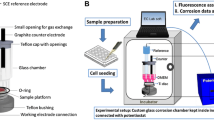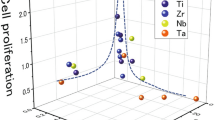Abstract
NiTi alloy is used in various medical applications and the surface titanium oxide layer produced naturally or enhanced artificially has been thought to offer a protecting film against allergic and toxic effects of nickel (Ni). In this study, we investigated the effect of different oxide layer thicknesses on the survival and attachment of osteoblastic cells (ROS-17/2.8). AFM, X-ray diffraction and electrical resistance measurements were used to analyze the surface properties of oxidized NiTi samples and the effect of oxidation on material properties. The results clearly showed that straight correlation between oxide thickness and cellular well-being cannot be maid. However, the different thicknesses of oxide layer on NiTi had surprising impacts on cellular responses and also to the properties of the metal alloy.



Similar content being viewed by others
References
L. G. GRIFFITH, Ann. N Y Acad. Sci. 961 (2002) 83
Z. SCHWARTZ and B. D. BOYAN, J. Cell. Biochem. 56 (1994) 340
J. Y. MARTIN, Z. SCHWARTZ, T. W. HUMMERT, D. M. SCHRAUB, J. SIMPSON, J. LANKFORD Jr, D. D. DEAN, D. L. COCHRAN and B. D. BOYAN, J. Biomed. Mater. Res. 29 (1995) 389
R. K. SINHA, F. MORRIS, S. A. SHAH and R. S. TUAN, Clin. Orthop. 305 (1994) 258
W. J. BUEHLER and F. E. WANG, Ocean Eng. 1 (1968) 105
T. SABURI, in “Shape memory materials”, edited by K. OTSUKA and C. M. WAYMANN (Cambridge University Press, New York, 1998), p. 49
D. M. BRUNETTE, P. TENGVALL, M. TEXTOR and P. THOMSEN, “Titanium in medicine” (Springer-Verlag, Berlin-Heidelberg-New York, 2001), p. 171
J. VAN HUMBEECK, R. STALMANS and P. A. BESSELINK, in “Metals as biomaterials”, edited by J. A. HELSEN and H. J. BREME (Chichester-Wiley, 1998), p. 73
D. J. WEVER, A. G. VELDHUIZEN, J. DE VRIES, H. J. BUSSCHER, D. R. UGES and J. R. VAN HORN, Biomaterials 19 (1998) 761
S. D. PLANT, D. M. GRANT and L. LEACH, Biomaterials 26 (2005) 5359
S. TRIGWELL, R. D. HAYDEN, K. F. NELSON and G. SELVADURAY, Surf. Interface Anal. 26 (1998) 483
G. S. FIRSTOV, R. G. VITCHEV, H. KUMAR, B. BLANPAIN and J. VAN HUMBEECK, Biomaterials 23 (2002) 4863
D. A. ARMITAGE, T. L. PARKER and D. M. GRANT, J. Biomed. Mater. Res. 66A (2003) 129
M. C. BECKERLE, J. Cell Biol. 103 (1986) 1679
C. E. TURNER, J. R. GLENNEY Jr and K. BURRIDGE, J. Cell Biol. 111 (1990) 1059
ASTM Diffraction Data File (ASTH, Philadelphia, 1969), 73-2224, 21-1276
A. KAPANEN, J. ILVESARO, A. DANILOV, J. RYHÄNEN, P. LEHENKARI and J. TUUKKANEN, Biomaterials 23 (2002) 645
P. Kostad, “High-temperature oxidation in metals” (Wiley, New York), p. 966
D. A. ARMITAGE and D. M. GRANT, Mater. Sci. Eng. A00 (2003) 89
R. O. HYNES, Cell 48 (1987) 549
E. ZAMIR and B. GEIGER, J. Cell Sci. 114 (2001) 3583
O. CISSE, O. SAVADOGO, M. WU and L. H. YAHIA, J. Biomed. Mater. Res. 61 (2002) 339
A. DIENER, B. NEBE, F. LUTHEN, P. BECKER, U. BECK, H. G. NEUMANN and J. RYCHLY, Biomaterials 26 (2005) 383
N. FAUCHEUX, R. SCHWEISS, K. LUTZOW, C. WERNER and T. GROTH, Biomaterials 25 (2004) 2721
N. FAUCHEUX and M. D. NAGEL, Biomaterials 23 (2002) 2295
B.-Z. KATZ, E. ZAMIR, A. BERSHADSKY, Z. KAM, K. M. YAMADA and B. GEIGER, Mol. Biol. Cell 11 (2000) 1047
A. J. GARCIA, M. D. VEGA and D. BOETTIGER, Mol. Biol. Cell 10 (1999) 785
R. THULL, Biomol. Eng. 19 (2002) 43
B. G. KESELOWSKY, D. M. COLLARD and A. J. GARCIA, J. Biomed. Mater. Res. 66 (2003) 247
H. NYGREN, P. TENGVALL and I. LUNDSTRÖM, J. Biomed. Mater. Res. 34 (1997) 487
F. F. VOLKENSTEIN (Nauka, Moscow, 1973), p. 234 (in Russian)
C. M. WAYMAN, in “Proceedings of the international symposium on shape memory effects and applications, Toronto, 1975”, edited by J. Perkins (Plenum Press, New York, 1975)
Acknowledgments
The authors thank Ms. Taina Poikela for technical assistance. This work was supported in part by the National Technology Agency of Finland (40245/03). V. M. was supported by the National Graduate School for Musculoskeletal Diseases in Finland.
Author information
Authors and Affiliations
Corresponding author
Rights and permissions
About this article
Cite this article
Muhonen, V., Heikkinen, R., Danilov, A. et al. The effect of oxide thickness on osteoblast attachment and survival on NiTi alloy. J Mater Sci: Mater Med 18, 959–967 (2007). https://doi.org/10.1007/s10856-006-0082-1
Received:
Accepted:
Published:
Issue Date:
DOI: https://doi.org/10.1007/s10856-006-0082-1




